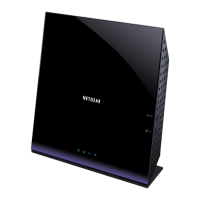
Do you have a question about the NETGEAR R6250 and is the answer not in the manual?
| Ethernet LAN | Yes |
|---|---|
| Networking standards | IEEE 802.11a, IEEE 802.11ac, IEEE 802.11b, IEEE 802.11g, IEEE 802.11n |
| Ethernet LAN data rates | 10, 100, 1000 Mbit/s |
| Ethernet LAN interface type | Gigabit Ethernet |
| Wi-Fi band | Dual-band (2.4 GHz / 5 GHz) |
| Ethernet LAN (RJ-45) ports | 4 |
| USB version | 3.2 Gen 1 (3.1 Gen 1) |
| Rack mounting | - |
| Frequency range | 2.4 - 5 GHz |
| xDSL connection | No |
| USB ports quantity | 1 |
| Minimum system requirements | - Internet Explorer 5.0, Firefox 2.0, Safari 1.4, Google Chrome 11.0 |
| Security algorithms | WPA, WPA2-PSK |
| Flash memory | 128 MB |
| Internal memory | 256 MB |
| Processor cores | 2 |
| Processor frequency | 800 MHz |
| Product color | Black |
| Windows operating systems supported | Windows 2000, Windows 2000 Professional, Windows 7 Home Basic, Windows 7 Home Basic x64, Windows 7 Home Premium, Windows 7 Home Premium x64, Windows 7 Professional, Windows 7 Professional x64, Windows 7 Starter, Windows 7 Starter x64, Windows 7 Ultimate, Windows 7 Ultimate x64, Windows 8, Windows 8 Enterprise, Windows 8 Enterprise x64, Windows 8 Pro, Windows 8 Pro x64, Windows 8 x64, Windows Vista Business, Windows Vista Business x64, Windows Vista Enterprise, Windows Vista Enterprise x64, Windows Vista Home Basic, Windows Vista Home Basic x64, Windows Vista Home Premium, Windows Vista Home Premium x64, Windows Vista Ultimate, Windows Vista Ultimate x64, Windows XP Home, Windows XP Professional |
| Depth | 65 mm |
|---|---|
| Width | 191 mm |
| Height | 198.5 mm |
| Weight | 417 g |
Open the box and remove the router, cables, and installation guide.
Familiarize yourself with the router's front, side, and back panels, and the label.
Locate essential router information such as WPS PIN, login info, MAC, and serial number.
Optimal placement for the router to ensure the best wireless connection range.
Step-by-step guide to setting up the router using the NETGEAR genie interface.
Instructions for updating the router's firmware to the latest version.
Overview of the router's basic status, network connection, and navigation.
Instructions for connecting your devices to the wireless network manually or via WPS.
Configure or view the router's basic Internet connection settings.
Set up and manage parental controls to filter objectionable content.
Configure the wireless network name (SSID) and basic security settings.
Understand and select wireless security protocols like WPA/WPA2.
Create a separate wireless network for visitors to use.
Use the wizard to automatically detect and configure your Internet connection.
Configure WAN settings like DMZ server, MTU size, and ping response.
Configure local area network settings, including DHCP and IP addressing.
Prioritize network traffic for specific applications or devices.
How to physically connect a USB storage device to the router.
Methods to access files on a connected USB storage device.
Configure network access and sharing settings for USB storage devices.
Enhance security by allowing only specific USB devices to share.
Connect and share a USB printer wirelessly through the router.
Software to manage and control shared USB printers and scanners.
Block specific websites or keywords from being accessed on the network.
Allow external access to servers on your local network.
Configure port triggering rules for dynamic port access.
Set schedules for blocking Internet access or specific content.
Steps to update the router's firmware for improved performance and security.
Monitor the router's current operational status and network information.
Back up, restore, or erase router configuration settings.
Set a new password for router login access.
Configure advanced wireless radio settings, schedules, and access lists.
Enable remote access to manage router settings over the Internet.
Configure IPv6 Internet connection types and settings.
Monitor and control Internet traffic volume and usage.
Interpret LED status indicators on the router for problem diagnosis.
Steps to resolve issues preventing login to the router's interface.
Steps to diagnose and resolve problems with internet connectivity.
Diagnose and fix problems connecting to the wireless network.
Information on resetting the router to its original factory default settings.
Detailed hardware and software specifications of the router.
General information on product compliance with national and international regulations.
EU directives and standards the product complies with.
FCC regulations and guidelines for product operation in the US.
Important information for users regarding FCC compliance.
Guidelines on FCC radiation exposure limits for equipment.
Official declaration stating the product's compliance with FCC rules.